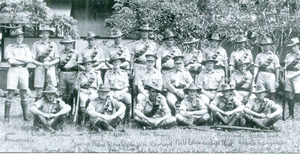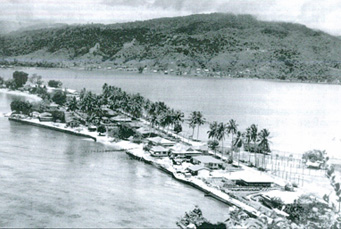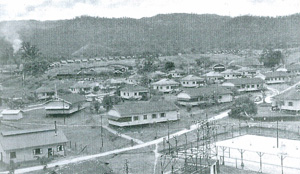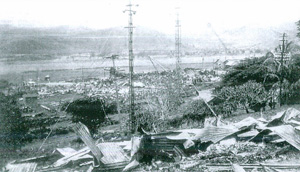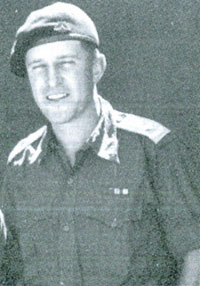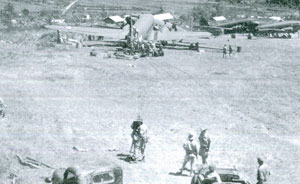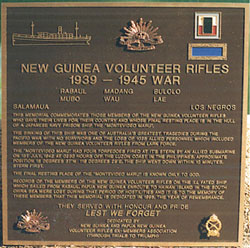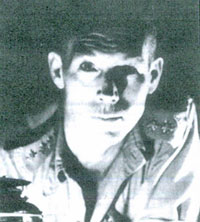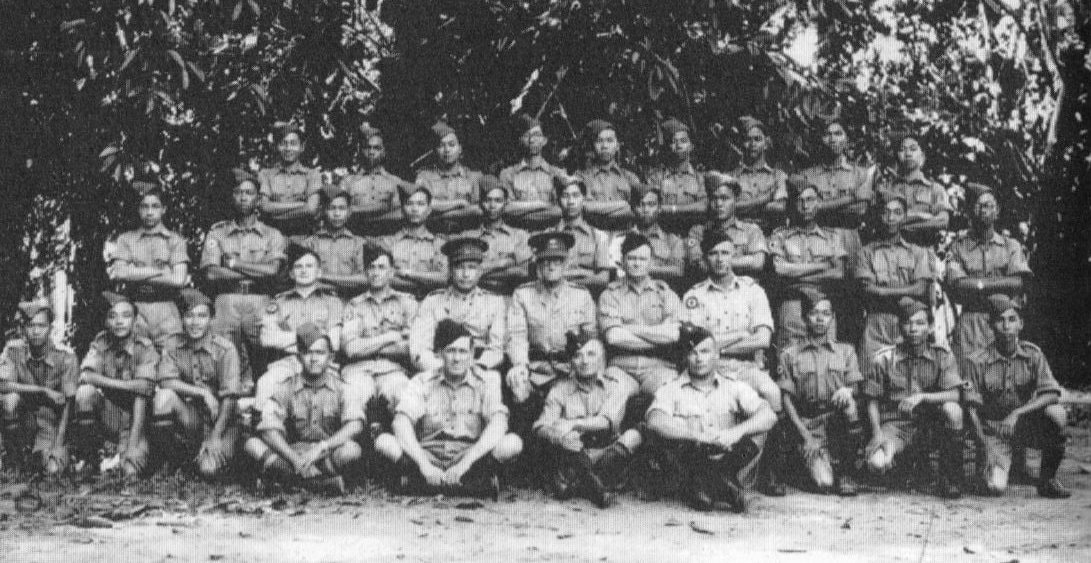NEW GUINEA VOLUNTEER RIFLES (NGVR)
|
|
The New Guinea Volunteer Rifles (NGVR) had the distinction of being the only Australian army militia unit raised, mobilised, fought and disbanded overseas in the Mandated Territory of New Guinea between 1939 and 1943. On 4th September 1939, Australian Army Headquarters ordered the raising of NGVR. A cosmopolitan group of men from Europe, the British Isles, New Zealand, Australia and Asia, whose homes and livelihoods were in New Guinea, hastened to join. The initial strength of the battalion was limited to 20 officers and 400 other ranks, but this was increased in June 1940 to 23 officers and 482 other ranks. The enthusiasm in the early days stemmed mainly from returned soldiers of the 1914-18 War, but by mid-1941 the unit had lost many of its younger members having joined the AIF and other services. While the remoteness of many areas was a disadvantage, a growing realisation of the danger of war in the Pacific led to a revival of interest late 1941. The headquarters of the NGVR was originally at Rabaul and sub-units were located at Wau, Salamaua, Lae and Madang. Fit men between the ages of 18 and 50 were accepted. Enlistment was for a two-year period and there was no pay except for an allowance of 1 pound per year. The uniform consisted of khaki shirts and trousers, made from material sent from Australia. The Army supplied felt hats, bandoliers, leather belts, boots and puttees. Brass NGVR shoulder badges were worn. Arms consisted of rifles and some Vickers and Lewis machine guns. In August 1941, after the arrival of ‘Lark Force’ in Rabaul, NGVR, under the command of Major WM Edwards, moved its headquarters to Bulolo on the mainland. After Japan attacked, the Battalion was placed on full-time duty and mobilized on the 21 January,1942. When the Japanese invaded Rabaul in the early hours of the 22 January, NGVR was under the command of the CO of 2/22nd Battalion. NGVR was positioned on the northern flank of the Lark Forces defence line around the harbour and manned medium machine guns and mortars. NGVR fought until resistance was of no avail, either sharing the fate of other prisoners-of-war or withdrawing south across New Britain to the Open Bay and Wide Bay areas for eventual evacuation south. Over 36 NGVR personnel of the 1053 plus Australian POWs and civilian miners from Rabaul and nearby New Guinea Islands died when the Japanese naval prison ship Montevideo Maru was sunk in the South China Sea on 1 July 1942 by an American submarine; the worst single Australian marine tragedy in WW2. Together, with about 150 other Australian soldiers, a number of NGVR soldiers were massacred at Toll Plantation on Wide Bay by the Japanese. On the mainland, NGVR formed independent detachments at Wau, Salamaua, Bulolo and Lae. On 21 January, when 60 Japanese aircraft struck simultaneously at Lae, Salamaua and Bulolo, the second-in-command of NGVR, Major EW Jenyns, went to the Administrator in Lae, who then declared a state of emergency and handed over to Jenyns. Assuming a Japanese landing at Lae was imminent and with NGVR on full time duty, all civilians departed on 24 January. This left six RAAF signalers and six NGVR soldiers in Lae. Meanwhile, other NGVR groups defended strategic points in the area, with their headquarters at Mubo. NGVR was at about company strength in the Lae area by this time. When the Japanese invaded Lae on 8 March 1942, NGVR moved westward towards Nadzab. After the Japanese landed at Salamaua on the same day, NGVR withdrew across the Francisco River and destroyed the bridge. Positioning a section at the river, the others moved south to Mubo. Although the Japanese appeared to be in no hurry to move inland, a party of 60 went to Komiatum, half way to Mubo, on 18 March and destroyed the NGVR stores dump. While the Japanese kept to the Lae town area, NGVR faced new problems. As the only administrative representative of law and order, it assumed responsibility for several thousand indentured labourers recruited from many outlying districts, but now without support and unable to return to their homes. The NGVR established depots and fed them, and they became the first of the army of carriers and labourers who proved so vital in their support to the Allies during the fighting that followed. Colonel Edwards sent six NGVR soldiers to find out what the Japanese were doing in Salamaua The Japanese knew they were there but failed to find them. As the local people were in trouble with the Japanese for assisting the Australians, NGVR withdrew to avoid further trouble for them. Similar NGVR posts were established along the Markham Valley and Heath’s Plantation closer to Lae to watch the Japanese. NGVR filled a large gap to late May 1942 by keeping in touch with and containing the enemy. The first reinforcements to reach NGVR at Wau were reinforcements originally designed for the 2/1st independent Coy which was decimated in the Japanese attacks on Manus Is, Rabaul and Kavieng. They were diverted to Wau and walked in over the Bulldog Track. The 2/5th Independent Company AIF, with supporting attachments, flew into Wau from Port Moresby on 23 May to reinforce NGVR. These units formed Kanga Force, whose role was to start a limited offensive to harass and destroy enemy personnel and equipment in the area. The OC Kanga Force considered there were 2,000 Japanese in Lae and 250 in Salamaua. Kanga Force had 700 men, of whom only 450 were fit for operations – a small number to meet the many possible Japanese threats. To forestall these, the OC ordered raids on Salamaua and Heath’s Plantation west of Lae. The Salamaua raid was planned quickly as a result of previous scouting work. Early in the morning of 29 June, 71 members of NGVR and 2/5th Independent Company killed at least 100 Japanese at a cost of three men slightly wounded. This very successful raid made the Japanese draw on their garrison at Lae to reinforce their perimeter at Salamaua. Although the 58 man strong raid on Heath’s Plantation was successful, it lacked surprise and the leader was killed and two other men wounded. Although NGVR remained in good spirits, the deprivations of continuous operations in hostile terrain without adequate supply and medication took their toll, with many falling sick with fever and other tropical diseases. The number of fit men steadily dwindled. As food was not getting through, the soldiers became increasingly dependent on the local food supply. Japanese air raids, their intimidation tactics over the local people, and the sheer physical difficulty of getting rations forward to feed carriers had a cumulative effect and threatened to stop Kanga Force activity. Later, when the focus shifted to the Milne Bay and Kokoda Track battles, NGVR continued to man its posts overlooking the Japanese. 1942 was NGVR’s year. By early 1943 too few were left to be effective. Because of their knowledge of the country and its problems, the remaining NGVR soldiers were attached to the Australian New Guinea Administrative Unit (ANGAU), and NGVR lost its identity. The NGVR soldiers came from many walks of life. While some were too old to join the AIF, medically unfit or employed in restricted occupations, they fought well. They also initiated the organising Papua New Guinean labour which was to become a vital contributory feature to the success of the Allied campaign in the New Guinea archipelago. Excerpted from Coady’s article in the “Australian Territories magazine”, published 1995-96. To obtain information regarding personal lives of NGVR soldiers, see the book "Keepers of the Gate" by MAJ F.J. (Bob) Collins - in "Suggested Reading" For a more detailed account of NGVR, see Ian Downes book “NGVR”. Additional information can be found at: http://en.wikipedia.org/wiki/New_Guinea_Volunteer_Rifles http://www.australian-pow-ww2.com/ng_rifles_7.html A History of NGVR
The address given by Bob Collins at the 80th Anniversary luncheon luncheon to commemorate the formation of the NGVR.
| ||||||||||||||||||
The story of Lt Gilbert Stuart Robertson is told below.
It is detailed and a wonderful history of how NGVR and ANGAU operated during WWII.
Gilbert Robertson's history has been researched and written by his grandson Kenneth Duus.
It is detailed and a wonderful history of how NGVR and ANGAU operated during WWII.
Gilbert Robertson's history has been researched and written by his grandson Kenneth Duus.
| Lieutenant Gilbert Stuart Tasma Robertson Service history NGVR_ANGAU | |
| File Size: | 10309 kb |
| File Type: | |
Chinese Auxiliary Ambulance Detachment
A little known fact about the NGVR was the establishment of the Chinese Auxiliary Ambulance Detachment. NGVR was only open to Europeans and Chinese were not allowed to enlist. although 4 did so at Bulolo - Shui Hong Wong (NG2448), Kim Thai Chan (NG2428), Chou Lai Bruno Seeto (NG2430) and Chu Kitt Seeto (NG2529).
Shui Hong Wong's story is told in 'Keepers of the Gate' - see above or "Suggested reading/viewing)'
In Rabaul, Chinese men who were unable to join the NGVR, formed the Chinese Auxiliary Ambulance Detachment (CAAD) and trained for medical services under Warrant Officer R.L. Kennedy (NG4038) of the NGVR. Kennedy was subsequently captured and executed by the Japanese at Tol Plantation. The fact that his number is NG4038 means that his papers were lost in Rabaul when the Japanese invaded and his number was issued after war's end.
The failure to evacuate Chinese women and children to Australia prior to the Japanese invasion was a factor why only four young Chinese members of the CAAD reported for duty at the time the NGVR was called up for full time duty. These were Ben Cheong, Siu Ban Cheong, Leo Kam On and Chee Chai and they saw medical service attached to Lark Force Medical sections. Some days after the Japanese invasion, with no organised defensive action in operations, these four CAAD members were advised by army personnel with whom they were associated to destroy their uniform and drift back into the local Chinese community. This they did and saw the war out under Japanese occupation.
Leo Kam On's story is told in 'Keepers of the Gate' - see above or 'Suggested reading/viewing.'
A little known fact about the NGVR was the establishment of the Chinese Auxiliary Ambulance Detachment. NGVR was only open to Europeans and Chinese were not allowed to enlist. although 4 did so at Bulolo - Shui Hong Wong (NG2448), Kim Thai Chan (NG2428), Chou Lai Bruno Seeto (NG2430) and Chu Kitt Seeto (NG2529).
Shui Hong Wong's story is told in 'Keepers of the Gate' - see above or "Suggested reading/viewing)'
In Rabaul, Chinese men who were unable to join the NGVR, formed the Chinese Auxiliary Ambulance Detachment (CAAD) and trained for medical services under Warrant Officer R.L. Kennedy (NG4038) of the NGVR. Kennedy was subsequently captured and executed by the Japanese at Tol Plantation. The fact that his number is NG4038 means that his papers were lost in Rabaul when the Japanese invaded and his number was issued after war's end.
The failure to evacuate Chinese women and children to Australia prior to the Japanese invasion was a factor why only four young Chinese members of the CAAD reported for duty at the time the NGVR was called up for full time duty. These were Ben Cheong, Siu Ban Cheong, Leo Kam On and Chee Chai and they saw medical service attached to Lark Force Medical sections. Some days after the Japanese invasion, with no organised defensive action in operations, these four CAAD members were advised by army personnel with whom they were associated to destroy their uniform and drift back into the local Chinese community. This they did and saw the war out under Japanese occupation.
Leo Kam On's story is told in 'Keepers of the Gate' - see above or 'Suggested reading/viewing.'

